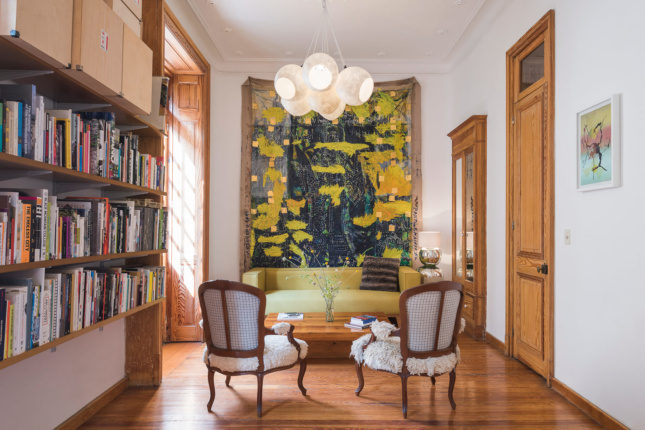
This article appears in AN Interior’s sixth edition—if you’re not a subscriber, there’s still time to buy it on newsstands! See our list of stores here.
Ana Paula Ruiz Galindo and Mecky Reuss, of Mexico City–based Pedro&Juana, met in 2005 while attending SCI-Arc (the Southern California Institute of Architecture). The pair then spent about four years at Jorge Pardo Sculpture (JPS) in L.A. They launched Pedro&Juana in 2012, after moving to Mexico City from Mérida, Mexico, where Pardo had been building a hacienda. In the years since, the firm has developed a series of architecture- and furniture-driven designs, including installations for the 2015 Chicago Architecture Biennial (CAB), 2016 Design Miami showcase, and an upcoming design for the Commons, a multiuse engagement space at the Museum of Contemporary Art in Chicago. In all of their projects, they furnish public areas with furniture of their own design, imbuing utilitarian spaces with a joyful energy and effervescent wit. Those sensibilities—and some of those furniture pieces—are fully realized throughout the pair’s recently renovated, 1,200-square foot Mexico City apartment.
“We kind of just did it the way we wanted to,” Ruiz Galindo said, describing the radical renovations the pair made to their fanciful apartment in the city’s Colonia Juárez neighborhood. The residence is located in a two-story, 176-unit neoclassical building built in 1913 as housing for the administrative staff of a local tobacco company called El Buen Tono.
The apartment had a long history of deferred maintenance and disjointed alterations that allowed the designers to reprogram the spaces as they saw fit. “We eradicated hallways and, typologically speaking, went back in time,” Reuss said. The flip was simple: Service areas were consolidated and modernized in the front of the apartment, while bedrooms were moved to the back. The unit’s two patio spaces were revamped too, with one receiving a wooden deck and the other a masonry floor. The wooden deck sits above an open basement level designed to passively cool the unit. To access the basement, Ruiz Galindo and Reuss added a new spiral staircase made from salvaged wooden beams left over from the construction. “That basement can be a problem. In our neighborhood the city sinks between 10 and 15 centimeters every year,” Reuss said, explaining Colonia Juárez’s extra-porous subterranean landscape. When it rains, the apartment’s basement sometimes floods as a result.
The main bedroom’s floor was replaced. There, the designers painted the new floors white to match the walls and ceilings of the room. A low, wide bed fills a space shared with a rocking chair and a lamp prototype leftover from their days at JPS. A nearby bathroom is decorated with brick checkerboard floors and a colorful array of citrus-hued tiles. The kitchen, simply articulated and looking out over the masonry floor courtyard, features built-in cabinetry and wooden countertops. Water damage from semi-seasonal flooding left the original pine floors in the dining room rotted through, so Ruiz Galindo and Reuss replaced them. The new pine floors match the casework, everything a crisp hue of light golden brown. Deeply recessed French doors cut into the exterior masonry walls of the room, opening out onto a shared courtyard. The doors, studded with divided lights and paneling, like the wide sweeps of crown molding above, echo the Beaux Arts provenance of the building.
The rest is a mix of contemporary objects and hand-me-downs: utilitarian bracketed bookshelves, prototype chairs and leftover lamps from the CAB installation, a pair of cabriole-leg chairs upholstered in yak wool. Stacks of tiny objects abound too, including groupings of the firm’s Maceta ceramic pot, a stackable vessel made of inverted, symmetrical cones of clay. These objects, Reuss said, are “the residues and leftover prototypes, extras that [over time] started to populate our house.”